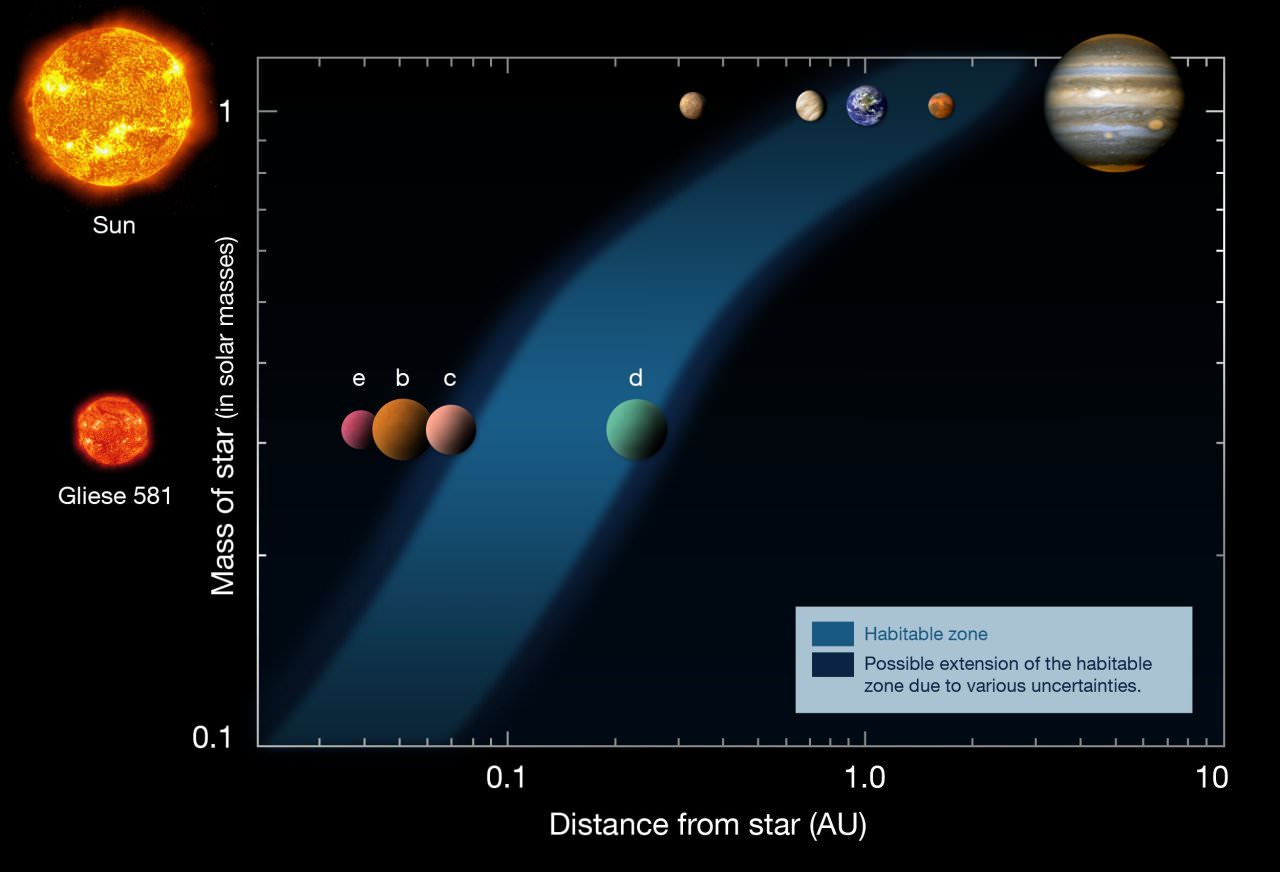[/caption]
Habitable zones are the regions around stars, including our own Sun, where conditions are the most favourable for the development of life on any rocky planets that happen to orbit within them. Generally, they are regions where temperatures allow for liquid water to exist on the surface of these planets and are ideal for “life as we know it.” Specific conditions, due to the kind of atmosphere, geological conditions, etc. must also be taken into consideration, on a case-by-case basis.
Now, by examining trace elements in the host stars, researchers have found clues as to how the habitable zones evolve, and how those elements also influence them. To determine what elements are in a star, scientists study the wavelengths of its light. These trace elements are heavier than the hydrogen and helium gases which the star is primarily composed of. Variations in the composition of these stars are now thought to affect the habitable zones around them.
The study was led by Patrick Young, a theoretical astrophysicist and astrobiologist at Arizona State University. Young and his team presented their findings on January 11, 2012 at the annual meeting of the American Astronomical Society in Austin, Texas. He and his colleagues have examined more than a hundred dwarf stars so far.
An abundance of these elements can affect how opaque a star’s plasma is. Calcium, sodium, magnesium, aluminum and silicon have been found to also have small but significant effects on a star’s evolution – higher levels tended to result in cooler, redder stars. As Young explains, “The persistence of stars as stable objects relies on the heating of plasma in the star by nuclear fusion to produce pressure that counteracts the inward force of gravity. A higher opacity traps the energy of fusion more efficiently and results in a larger radius, cooler star. More efficient use of energy also means that nuclear burning can proceed more slowly, resulting in a longer lifetime for the star.”
The lifetime of a star’s habitable zone can also be influenced by another element – oxygen. Young continues: “The habitable lifetime of an orbit the size of Earth’s around a one-solar-mass star is only 3.5 billion years for oxygen-depleted compositions but 8.5 billion years for oxygen-rich stars. For comparison, we expect the Earth to remain habitable for another billion years or so, for about 5.5 billion years total, before the Sun becomes too luminous. Complex life on Earth arose some 3.9 billion years after its formation, so if Earth is at all representative, low-oxygen stars are perhaps less than ideal targets.”
As well as the habitable zone, the composition of a star can determine the eventual composition of any planets that form. The carbon-oxygen and magnesium-silicon ratios of stars can affect whether a planet will have magnesium or silicon-loaded clay minerals such as magnesium silicate (MgSiO3), silicon dioxide (SiO2), magnesium orthosilicate (Mg2SiO4), and magnesium oxide (MgO). A star’s composition can also play a role in whether a rocky planet might have carbon-based rock instead of silicon-based rock like our planet. Even the interior of planets could be affected, as radiocative elements would determine whether a planet has a molten core or a solid one. Plate tectonics, thought to be important for the evolution of life on Earth, depend on a molten interior.
Young and his team are now looking at 600 stars, ones that are already being targeted in exoplanet searches. They plan to produce a list of the 100 best stars which could have potentially habitable planets.


The overall result is interesting, that lifetime of the star and hence the habitable zone (HZ) is so affected by opacity. However as it would be a conference proceeding, the result, possibly only theoretical so far, has to be tested a bit more.
The conference format would explain the popular but important application to the habitability zone, as well as the mixing of high and low points. For example, the discussion of twice the amount of UV is a bit misplaced as habitability concern. Most of the sun UV is blocked by our atmosphere involving an oxygen feedback mechanism in our mature atmosphere and leaving ~ 2-3 % of the original strength. Ocean water is an efficient blocker. And to top it off, ozone depletion subjects the tropics to ~ 2x the pre-industrial UV level.
What it comes down to is that the planetary properties are dominating over star properties for basic habitability. I would guess that water is the most sensitive compound. Earth has ~ 0.005 % water by weight. A factor ten less would have left us dry and presumably without plate tectonics, because Earth mass is marginal for having that. A factor ten more would have drowned the plates anyway, which is fine for fish schools but not so much for technological societies.
The star HZ lifetime variation would go into a model of the galactic HZ (GHZ) model. The older the galaxy the more fecund it becomes as older star populations gets more metals and a planetary GHZ migrates outward.
The GHZ is delimited by the lower limit of HZ to possibly have a robust prokaryote biosphere. Eukaryotes, the basis for complex multicellularity, seems to be a low likelihood event and can thus happen at any time. As small complex multicellulars can live of hydrogen instead of oxygen such life is constrained, but not severely so, by a 3.5 billion year lower HZ limit for G stars.
In any case the most numerous stars are M stars and are expected to have most terrestrials anyway. Their HZ lifetimes is on the order of ~ 100 billion years.